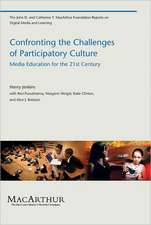Taking Design Thinking to School: How the Technology of Design Can Transform Teachers, Learners, and Classrooms
Editat de Shelley Goldman, Zaza Kabayadondoen Limba Engleză Paperback – 17 noi 2016
| Toate formatele și edițiile | Preț | Express |
|---|---|---|
| Paperback (1) | 438.05 lei 6-8 săpt. | |
| Taylor & Francis – 17 noi 2016 | 438.05 lei 6-8 săpt. | |
| Hardback (1) | 1001.07 lei 6-8 săpt. | |
| Taylor & Francis – dec 2016 | 1001.07 lei 6-8 săpt. |
Preț: 438.05 lei
Nou
Puncte Express: 657
Preț estimativ în valută:
83.85€ • 91.11$ • 70.48£
83.85€ • 91.11$ • 70.48£
Carte tipărită la comandă
Livrare economică 21 aprilie-05 mai
Preluare comenzi: 021 569.72.76
Specificații
ISBN-13: 9781138101005
ISBN-10: 1138101001
Pagini: 256
Ilustrații: 68
Dimensiuni: 152 x 229 x 18 mm
Greutate: 0.35 kg
Ediția:1
Editura: Taylor & Francis
Colecția Routledge
Locul publicării:Oxford, United Kingdom
ISBN-10: 1138101001
Pagini: 256
Ilustrații: 68
Dimensiuni: 152 x 229 x 18 mm
Greutate: 0.35 kg
Ediția:1
Editura: Taylor & Francis
Colecția Routledge
Locul publicării:Oxford, United Kingdom
Public țintă
PostgraduateCuprins
Foreword by Bernard Roth
SECTION I. DESIGN THINKING AND ITS EMERGENCE IN K-12 EDUCATION
Chapter 1. Taking Design Thinking to School: How the Technology of Design Can Transform Teachers, Learners, and Classrooms
Shelley Goldman and Zaza Kabayadondo
Chapter 2. The Culture of Practice: Design-Based Teaching and Learning
Meredith Davis and Deborah Littlejohn
Chapter 3. A Praxis Model for Design Thinking: Catalyzing Life Readiness
Christelle Estrada and Shelley Goldman
SECTION II. YOUNG DESIGNERS—K-12 STUDENTS TAKE ON DESIGN THINKING
Chapter 4. Design Partners in Schools: Encouraging Design Thinking Through Cooperative Inquiry
Mona Leigh Guha, Brenna McNally and Jerry Alan Fails
Chapter 5. Taking Design Thinking to East, West, and Southern Africa: Key Lessons from Global Minimum’s Student Innovation Programs
Desmond Mitchell and Mathias Esmann
Chapter 6. Capturing Middle School Students' Understandings of Design Thinking
Shelley Goldman, Molly B. Zielezinski, Tanner Vea, Stephanie Bachas-Daunert, Zaza Kabayadondo
Chapter 7. Adapting the User-Centered Design Framework for K-12 Education: The Riverside School Case Study
Mohanram Gudipati and Kiran Bir Sethi
SECTION III. DESIGN THINKING AS A CATALYST FOR REIMAGINING EDUCATION
Chapter 8. Build It In from the Start: A New School’s Journey to Embrace Design Thinking
Susie Wise
Chapter 9. ResponsiveDesign: Scaling out to transform educational systems, structures and cultures
Ralph Cordova, Ann Taylor, Phyllis Balcerzak, Michelle Whitacre and Jeffery Hudson
Chapter 10. Teachers as Designers of Context-Adaptive Learning Experience
Zanette Johnson
Chapter 11. To Succeed, Failure Must Be An Option
David Kwek
Chapter 12. Empathy in STEM Education
Kathy Liu Sun
SECTION IV. INSPIRING TEACHING: DESIGN THINKING IN THE CLASSROOM
Chapter 13. Professional Development That Bridges the Gap Between Workshop and Classroom Through Disciplined Improvisation
Jennifer Knudsen and Nicole Schectman
Chapter 14. The Materiality of Design in E-Textiles
Verily Tan, Anna Kuene, and Kylie Peppler
Chapter 15. Finding Your Fit: Empathy, Authenticity, and Ambiguity in the Design Thinking Classroom
Molly B. Zielezinski
Chapter 16. Analyzing Materials in Order to Find Design Opportunities for the Classroom
Charlie Cox, Xorman Apedoe, Eli Silk, and Christian Schunn
Chapter 17. Developing Powerful, Portable Design Thinking: The Innovators’ Compass
Ela Ben-Ur
SECTION I. DESIGN THINKING AND ITS EMERGENCE IN K-12 EDUCATION
Chapter 1. Taking Design Thinking to School: How the Technology of Design Can Transform Teachers, Learners, and Classrooms
Shelley Goldman and Zaza Kabayadondo
Chapter 2. The Culture of Practice: Design-Based Teaching and Learning
Meredith Davis and Deborah Littlejohn
Chapter 3. A Praxis Model for Design Thinking: Catalyzing Life Readiness
Christelle Estrada and Shelley Goldman
SECTION II. YOUNG DESIGNERS—K-12 STUDENTS TAKE ON DESIGN THINKING
Chapter 4. Design Partners in Schools: Encouraging Design Thinking Through Cooperative Inquiry
Mona Leigh Guha, Brenna McNally and Jerry Alan Fails
Chapter 5. Taking Design Thinking to East, West, and Southern Africa: Key Lessons from Global Minimum’s Student Innovation Programs
Desmond Mitchell and Mathias Esmann
Chapter 6. Capturing Middle School Students' Understandings of Design Thinking
Shelley Goldman, Molly B. Zielezinski, Tanner Vea, Stephanie Bachas-Daunert, Zaza Kabayadondo
Chapter 7. Adapting the User-Centered Design Framework for K-12 Education: The Riverside School Case Study
Mohanram Gudipati and Kiran Bir Sethi
SECTION III. DESIGN THINKING AS A CATALYST FOR REIMAGINING EDUCATION
Chapter 8. Build It In from the Start: A New School’s Journey to Embrace Design Thinking
Susie Wise
Chapter 9. ResponsiveDesign: Scaling out to transform educational systems, structures and cultures
Ralph Cordova, Ann Taylor, Phyllis Balcerzak, Michelle Whitacre and Jeffery Hudson
Chapter 10. Teachers as Designers of Context-Adaptive Learning Experience
Zanette Johnson
Chapter 11. To Succeed, Failure Must Be An Option
David Kwek
Chapter 12. Empathy in STEM Education
Kathy Liu Sun
SECTION IV. INSPIRING TEACHING: DESIGN THINKING IN THE CLASSROOM
Chapter 13. Professional Development That Bridges the Gap Between Workshop and Classroom Through Disciplined Improvisation
Jennifer Knudsen and Nicole Schectman
Chapter 14. The Materiality of Design in E-Textiles
Verily Tan, Anna Kuene, and Kylie Peppler
Chapter 15. Finding Your Fit: Empathy, Authenticity, and Ambiguity in the Design Thinking Classroom
Molly B. Zielezinski
Chapter 16. Analyzing Materials in Order to Find Design Opportunities for the Classroom
Charlie Cox, Xorman Apedoe, Eli Silk, and Christian Schunn
Chapter 17. Developing Powerful, Portable Design Thinking: The Innovators’ Compass
Ela Ben-Ur
Descriere
Taking Design Thinking to School: How the Technology of Design Can Transform Teachers, Learners, and Classrooms uses an action-oriented approach to reframing K-12 teaching and learning, examining interventions that open up dialogue about when and where learning, growth and empowerment can be triggered.












